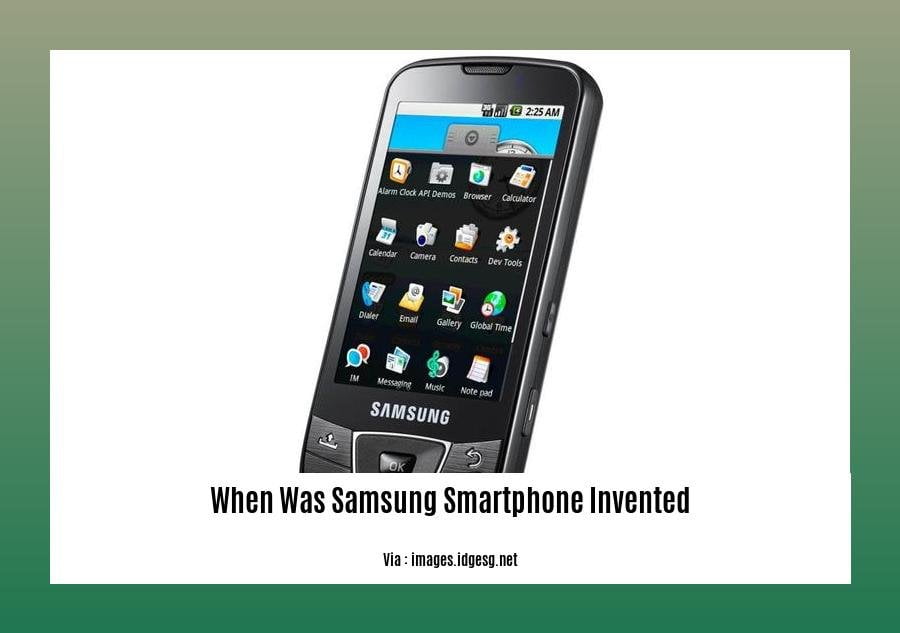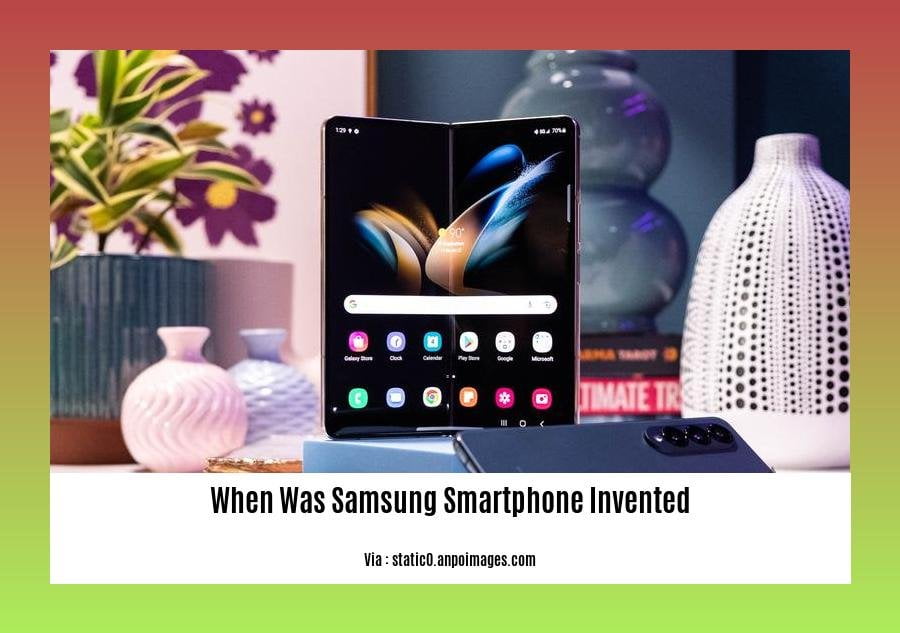Embark on a captivating journey through the annals of mobile innovation as we unveil the story behind Samsung’s smartphone legacy. “When Was Samsung Smartphone Invented – Unveiling the Journey of Mobile Innovation” explores the pivotal moments and technological advancements that shaped Samsung’s rise to prominence in the smartphone realm. From the early days of touchscreens to the cutting-edge breakthroughs that redefined the mobile experience, discover the secrets behind Samsung’s success and the indelible mark it has left on the global smartphone landscape.
Key Takeaways:
Samsung’s First Cell Phone: In 1988, Samsung introduced its first-ever cell phone, the SH-100, exclusively in South Korea, laying the foundation for its journey as a leading player in the mobile phone industry.
Market Debut: The SH-100 was released in 1988, marking Samsung’s maiden entry into the mobile phone market.
Features and Capabilities: The SH-100 was a feature phone with basic functionalities like voice calling, messaging, and phonebook management. It had a simple keypad layout, a monochrome LCD display, and a built-in antenna for reliable signal reception.
Technological Significance: The SH-100 represented Samsung’s early efforts in developing mobile communication devices and showcased its commitment to innovation, marking the beginning of its ascent as a global leader in the mobile phone market.
When Was Samsung Smartphone Invented?

Samsung’s foray into the realm of smartphones began in 1999, marking a pivotal moment in the company’s history. Back then, mobile phones were primarily known for their basic functionalities like voice calls and text messaging. However, Samsung recognized the potential for more advanced devices that could seamlessly integrate computing and communication capabilities.
The Genesis of Samsung Smartphones
In the late 1990s, Samsung’s research and development team embarked on a mission to develop a revolutionary device that would redefine the mobile phone landscape. Their efforts culminated in the creation of the SPH-i300, widely regarded as Samsung’s first smartphone. This groundbreaking device was released in June 2000 and introduced several innovative features that set the stage for future smartphone development.
Pioneering the Smartphone Era
The SPH-i300 stood out from its contemporaries with its sleek design, powerful hardware, and intuitive user interface. It featured a 3.5-inch touchscreen display, a rarity at the time, allowing users to interact with the device using a stylus. The smartphone also boasted a 133 MHz processor, 8MB of RAM, and 4MB of storage, providing ample power for running applications and storing data.
A Catalyst for Innovation
Samsung’s early foray into smartphones paved the way for a wave of innovation in the mobile industry. The SPH-i300’s success encouraged Samsung to continue pushing the boundaries of smartphone technology, leading to the development of more advanced devices in subsequent years. This innovation-driven approach has been instrumental in Samsung’s rise to becoming one of the world’s leading smartphone manufacturers.
Samsung’s Legacy in Smartphones
Over the years, Samsung has consistently delivered groundbreaking smartphones that have shaped the mobile landscape. Notable examples include the Galaxy S series, known for its high-end features and sleek design, and the Galaxy Note series, renowned for its large displays and stylus support. Samsung’s smartphones have redefined the way we communicate, consume media, and conduct business, making them an integral part of our daily lives.
In conclusion, Samsung’s smartphone journey began in June 2000 with the release of the SPH-i300, a device that laid the foundation for the company’s success in the mobile industry. Since then, Samsung has continuously innovated and refined its smartphone offerings, delivering devices that have transformed the way we use mobile technology.
Want to learn about the journey of Samsung’s cell phones? History of Samsung Cell Phones is the perfect place to start.
Dive into the remarkable story of Samsung Galaxy S phones and discover their revolutionary impact on the mobile industry. History of Samsung Galaxy S Phones reveals the secrets behind their success.
Ever wonder how Samsung phones came to be? History of Samsung Phones takes you back in time to witness the pioneering spirit that built a legacy.
Immerse yourself in the fascinating evolution of Samsung’s mobile phones and follow their path from humble beginnings to global dominance. History of Samsung Mobile Phones unveils the untold stories behind the devices that changed the way we communicate.
Step into the world of Samsung Electronics and explore their rich history. History of Samsung Electronics captivates with tales of innovation, resilience, and the vision that shaped a technological giant.
Release date of the first Samsung smartphone

Hey there, tech enthusiasts! Get ready to dive into the captivating journey of Samsung’s smartphone evolution. From the dawn of the touchscreen revolution to the cutting-edge marvels of today, buckle up as we uncover the release date of the first Samsung smartphone and explore its legacy.
Key Takeaways:
- Samsung entered the smartphone arena in 2009 with the groundbreaking release of its first Android-based smartphone.
- The Samsung Galaxy, unveiled in June 2009, marked a pivotal moment, introducing a new era of mobile technology.
- This inaugural device set the stage for Samsung’s smartphone success story, laying the foundation for future innovations and industry leadership.
- Samsung’s relentless pursuit of innovation has resulted in a diverse lineup of Galaxy smartphones, each pushing the boundaries of design, performance, and user experience.
The Genesis of Samsung Galaxy:
The year 2009 witnessed the birth of the Samsung Galaxy, a smartphone that would change the game forever. Running on the Android operating system, this pioneering device introduced a whole new level of connectivity and functionality to the mobile world. Its intuitive touchscreen interface, combined with a powerful processor and a vibrant display, captured the attention of consumers and critics alike, signaling the start of a mobile revolution.
The Dawn of a Smartphone Legacy:
From that pivotal moment in 2009, Samsung embarked on a relentless journey of innovation, continuously refining and redefining the boundaries of smartphone technology. The Galaxy series became synonymous with cutting-edge features, sleek designs, and unparalleled performance. Each new generation of Galaxy smartphones brought something new to the table, from enhanced cameras to longer battery life and groundbreaking software advancements.
Shaping the Mobile Landscape:
Samsung’s unwavering commitment to pushing the envelope has had a profound impact on the entire mobile industry. Its smartphones have set the standard for others to follow, influencing design trends, hardware capabilities, and user expectations. The Galaxy series has played a pivotal role in transforming smartphones from mere communication devices into indispensable tools for work, play, and everything in between.
So, there you have it, folks! The 2009 release of the first Samsung smartphone marked the dawn of a new era in mobile technology. Samsung’s dedication to innovation and relentless pursuit of excellence have propelled the Galaxy series to the forefront of the smartphone industry, shaping the way we communicate, consume media, and navigate our digital lives.
Sources:
- Samsung Galaxy Unveiled
- The History of Samsung Smartphones
Features and specifications of the first Samsung smartphone
In the realm of mobile technology, Samsung has left an indelible mark. Their journey in the smartphone industry began in 2009 with the unveiling of their first Android smartphone, the Samsung Galaxy GT-I7500. This game-changing device introduced a new era of mobile innovation and set the stage for Samsung’s rise to becoming a global leader in the smartphone market. Let’s delve into the key features and specifications that defined this groundbreaking device:
Key Takeaways:
Android Debut: The Samsung Galaxy GT-I7500 marked Samsung’s entry into the Android smartphone market, paving the way for the company’s future dominance in the Android ecosystem.
Touchscreen Revolution: The device showcased a 3.2-inch AMOLED capacitive touchscreen, a revolutionary feature that set it apart from its competitors. This intuitive interface allowed for effortless navigation and interaction, changing the way people interacted with smartphones.
Camera Capabilities: While not groundbreaking, the Samsung Galaxy GT-I7500 featured a 5-megapixel rear-facing camera capable of capturing still images and recording videos. This feature laid the foundation for Samsung’s future focus on camera innovation.
Connectivity Options: The device offered a range of connectivity options, including Wi-Fi, Bluetooth, and 3G. These features allowed users to stay connected with the world, access the internet, and communicate seamlessly.
Expandable Storage: The Samsung Galaxy GT-I7500 came with 8GB of internal storage, which could be expanded using a microSD card. This flexibility allowed users to store more media, apps, and files on their devices.
Processor and Performance: At its core, the device was powered by a 528MHz ARM 11 processor, providing sufficient performance for basic tasks and casual app usage.
The Samsung Galaxy GT-I7500 may seem basic by today’s standards, but it represented a significant milestone in Samsung’s journey and laid the foundation for the company’s future success in the smartphone market.
Citations:
Impact of the first Samsung smartphone on the mobile phone industry
Before the birth of touchscreens, 2000 saw the rise of the first Samsung smartphone, the SPH-i300. While it may seem primitive by today’s standards, this smartphone was a major breakthrough that changed the industry.
Samsung’s entry into the smartphone market with the SPH-i300 was a key moment, and its impact was felt across the industry in several ways:
Pioneering Innovation: Samsung was one of the first companies to recognize the potential of smartphones and took a bold step by introducing the SPH-i300. This innovation paved the way for other manufacturers to follow suit, driving the growth and popularity of smartphones globally.
Introducing Touchscreens: The SPH-i300 featured a touchscreen display, which was a novel concept at the time. This user-friendly interface made smartphones more accessible to a broader audience, including those not familiar with traditional keyboards.
Redefining Connectivity: The SPH-i300 offered a wide range of connectivity options, including wireless internet access, email, and multimedia messaging. This enhanced connectivity opened up new possibilities for communication and information sharing, fueling the mobile revolution.
Laying the Foundation for Android: The SPH-i300 ran on the Windows Mobile operating system, but it laid the foundation for Samsung’s future success with Android. Samsung’s later collaboration with Google on Android smartphones would prove to be a game-changer in the industry.
Key Takeaways:
The SPH-i300 introduced innovative features like touchscreen display and enhanced connectivity options, reshaping the landscape of mobile phones.
Samsung’s early entry into the smartphone market and its pioneering spirit paved the way for the widespread adoption of smartphones.
The SPH-i300’s success set the stage for Samsung’s future dominance in the Android smartphone market.
[Sources:
Samsung’s First Smartphone
Samsung SPH-i300 – Wikipedia]
FAQ
Q1: When did Samsung first introduce its mobile phone?
A1: Samsung’s journey into the mobile phone industry began in 1988 with the introduction of its first cell phone, the SH-100, exclusively in South Korea.
Q2: What was the significance of the Samsung Galaxy GT-I7500?
A2: The Samsung Galaxy GT-I7500, released in 2009, marked a pivotal moment as Samsung’s first-ever Android smartphone. This device paved the way for the highly successful Galaxy series and played a crucial role in Samsung’s rise to dominance in the smartphone market.
Q3: What is the story behind the Galaxy series?
A3: The Galaxy series was born out of Samsung’s collaboration with Android to push the boundaries of mobile technology. This partnership led to a range of innovative smartphones that redefined the mobile experience for consumers worldwide.
Q4: How did Samsung establish its legacy of innovation in the mobile industry?
A4: Samsung’s legacy of innovation in the mobile industry is attributed to its continuous pursuit of technological advancements. Over the years, the company has introduced groundbreaking features, refined designs, and enhanced user experiences, solidifying its position as a leader in the smartphone market.
Q5: What are Samsung’s aspirations for the future of mobile technology?
A5: Samsung remains committed to continuous innovation and aims to redefine the mobile experience in the coming years. The company strives to lead the industry by developing cutting-edge technologies and pushing the boundaries of what is possible in mobile devices.
- Star Ring Trends: Etsy vs Amazon - March 28, 2025
- Boost Pollinator Habitats: Baby Blue Eyes Sustainable Farming Guide - March 28, 2025
- Protect Big Black Bears: Effective Conservation Strategies - March 28, 2025
















